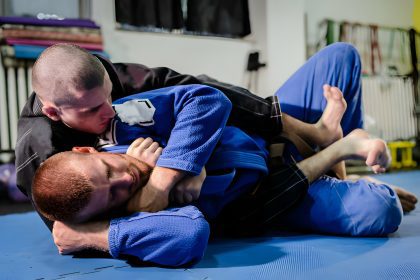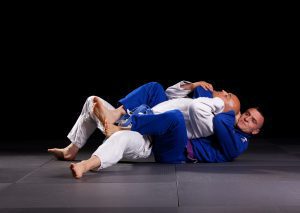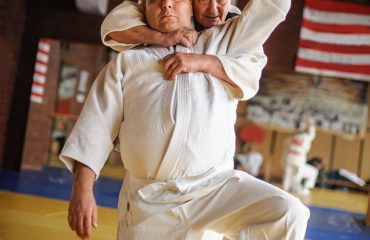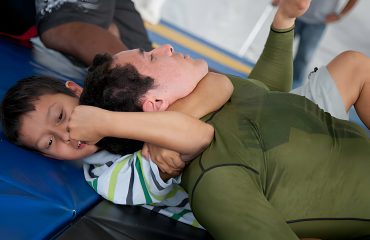
NOCO BJJ: Mastering Blood Choke vs Air Chokes Guide
The Subtle Art of Chokes in BJJ
In the dynamic world of Brazilian Jiu-Jitsu (BJJ), mastering various choking techniques is essential. At NOCO Jiu-Jitsu and Self-Defense, we explore the intricacies of two primary choke types: blood chokes and air chokes. Understanding the difference between these techniques is crucial for both effective application and safe practice. In this comprehensive guide, we’ll explore the nuances of “blood choke vs air choke,” enhancing your BJJ knowledge and skills.
Blood choke works by restricting the flow to the brain through the opponent’s neck, cutting off the oxygen supply and causing unconsciousness within a few seconds if properly applied. This type of choke can be incredibly effective in a self defense situation, but it must be applied with caution to avoid permanent damage or brain damage. Air choke, on the other hand, compress the upper airway, blocking the opponent’s breathing. Techniques like the tracheal choke can cause severe discomfort and panic, making them useful in certain combat sports scenarios. However, if applied incorrectly, air chokes can be more dangerous, leading to brain damage or even death if the opponent is unable to breathe for an extended period.
Both choke types require precise technique and an understanding of martial arts principles. Whether you’re using one arm or both, your legs, or the opponent’s head, proper application is key to ensuring safety and effectiveness. Unlike in mixed martial arts or other martial arts, where strikes and different holds are common, BJJ focuses heavily on submission through chokes and holds. In any self defense situation, it’s vital to recognize the signs when an opponent is close to losing consciousness to prevent any permanent damage. Training at NOCO emphasizes applying these techniques responsibly and understanding the physiological effects on the brain and body, enhancing both proficiency and safety in real-life defense situations.
The Basics of Choking Techniques

Before diving into the specifics, it’s important to grasp the basic concept of a choke in BJJ. A choke is a grappling technique designed to restrict your opponent’s airway or blood flow, leading to submission. The effectiveness of a choke lies in its ability to incapacitate an opponent, making it a powerful tool in the arsenal of any BJJ practitioner. Understanding the distinction between a blood choke vs. air choke is crucial in this context.
This technique, when executed correctly, can swiftly shift the balance of a match, demonstrating the importance of skill and precision in BJJ. It’s not just about physical strength; it’s about understanding the mechanics of the human body and applying techniques in the most efficient way possible.
In BJJ, the art of choking is not about brute force; it’s about finesse and timing. A well-timed choke, whether it’s a blood choke or an air choke, can subdue even the most formidable opponents, highlighting the strategic nature of this martial art. Blood chokes work by restricting the blood flow to the brain, causing unconsciousness within a few seconds if properly applied.
This can raise blood pressure momentarily as the brain is deprived of oxygen. Air chokes, on the other hand, compress the upper airway, blocking the opponent’s breathing and potentially causing panic or death if the opponent is unable to breathe for an extended period.
Whether using one arm, both arms, or the legs, precise technique is essential to avoid permanent damage. This is particularly important in a self defense situation or combat sports like mixed martial arts, where safety and effectiveness are paramount. Unlike in other martial arts, BJJ focuses heavily on submission through chokes and holds.
At NOCO Jiu Jitsu and Self Defense, we emphasize the importance of mastering these fundamental aspects, ensuring our students develop both their physical and mental capabilities. Recognizing when an opponent is close to losing consciousness is vital to prevent serious injury, making BJJ a deeply rewarding practice that challenges both the body and mind.
Blood Chokes: Targeting the Carotid Arteries

Blood chokes, also known as strangulations, are techniques that restrict blood flow to the brain by applying pressure to the sides of the neck, specifically the carotid artery or arteries. These chokes are often considered more efficient and safer for training, as they can render an opponent unconscious more quickly and with less force. The effectiveness of a blood choke lies in their ability to subtly incapacitate an opponent without causing undue harm, making them a preferred technique in both competitive and training environments.
When properly applied, a blood choke can make an opponent lose consciousness within a few seconds due to the rapid reduction of oxygen supply to the brain. Techniques like the lateral vascular neck restraint involve using one arm or your own arm to compress the carotid arteries while the legs or other body parts control the opponent’s head and body. This technique increases blood pressure temporarily as the body reacts to the sudden drop in oxygenated blood flow.
- Mechanics of Blood Chokes: Understanding the precise application of pressure is key. It involves positioning your arm or leg in such a way that it applies pressure to both carotid arteries without putting excessive force on the windpipe. This requires a combination of proper positioning, leverage, and timing to execute effectively.
- Examples and Execution: Techniques like the Rear Naked Choke and Triangle Choke are prime examples of blood choke. The Rear Naked Choke is executed from behind the opponent, using the arms to apply pressure on the neck, while the Triangle Choke is performed from a frontal position, typically using the legs. Both require detailed knowledge of body mechanics to apply safely and effectively.
- Safety and Responsiveness: Recognizing signs of a successful blood choke is crucial for safe practice. This includes monitoring the opponent’s reactions and being prepared to release the choke immediately upon a tap-out. Practitioners must be vigilant and responsive to ensure the safety of their training partners.
In a defense situation, understanding the correct application of a blood choke is crucial to avoid dangerous outcomes such as permanent damage or death. Unlike other martial arts, BJJ emphasizes precision and control, ensuring that techniques like blood chokes are used safely. Recognizing the point at which an opponent is about to lose consciousness is vital, as holding the choke too long can be harmful. This attention to detail makes BJJ a highly effective and safe practice for both self-defense and sport.
In addition to these points, it’s important to note the subtleties of applying blood chokes. The objective is not to cause discomfort but to efficiently cut off the blood supply to the brain. This requires a level of finesse and control, which is developed through consistent practice and guidance from experienced instructors like those at NOCO Jiu-Jitsu and Self-Defense. Our training emphasizes not only the technical aspects of these chokes but also the ethical responsibility that comes with learning such powerful techniques.
Air Chokes: Compressing the Windpipe

In contrast, air choke involves applying pressure directly to the windpipe. These chokes can be more uncomfortable and potentially dangerous, requiring careful application and a thorough understanding of the technique. Unlike blood chokes, which target the carotid arteries, an air choke focus on obstructing the air passage, making it crucial for practitioners to apply them with precision and control.
- Understanding Air Chokes: The mechanics of compressing the trachea involve a delicate balance. It’s not just about applying pressure; it’s about knowing exactly where and how much pressure to apply. This understanding is critical to prevent injury and to execute the choke effectively.
- Common Air Choke Techniques: Examples include the Guillotine Choke and Arm Triangle. Each of these techniques has its unique application and nuances. The Guillotine Choke, for instance, is applied from in front of the opponent and can be executed both standing and on the ground. The Arm Triangle, on the other hand, is typically applied from a side control position, using the practitioner’s arm and body to compress the opponent’s neck against their shoulder.
- Practicing with Caution: Ensuring safety while applying an air choke is paramount. This involves not only understanding the technique itself but also being aware of the signs of distress in your training partner. Practitioners must learn to apply these chokes gradually, giving their partners enough time to tap out. It’s also essential to practice these techniques under the supervision of an experienced instructor who can provide immediate feedback and guidance.
In addition to these points, it’s important to recognize the situational effectiveness of air chokes in BJJ. While they can be powerful tools in your grappling arsenal, their application must be timed well and executed within the right context. At NOCO Jiu-Jitsu and Self-Defense, we stress the importance of scenario-based training, where students learn not only how to apply these chokes but also when to use them effectively in various grappling situations. This comprehensive approach ensures that our students are well-equipped with both the technical skills and the tactical acumen necessary for successful grappling.
Comparative Analysis: Blood Choke vs Air Choke
Understanding the differences between these two types of chokes is crucial for effective application and safety. We’ll compare their mechanics, effects, risks, and appropriate contexts for use. Blood chokes, focusing on restricting blood flow to the brain, are generally considered safer and more efficient in BJJ. They require a deep understanding of anatomy and precise techniques to apply pressure correctly to the carotid arteries. The key to a successful blood choke is not brute strength but the strategic application of force in the right areas.
Air chokes, on the other hand, target the windpipe and can be more immediate in their effect. However, they carry a higher risk due to the potential for damage to the trachea. The application of an air choke demands not only physical control but also a high level of awareness and responsibility from the practitioner. It’s crucial to apply these chokes with a clear understanding of the risks involved and to practice them in a controlled environment under expert supervision.
In terms of application, blood chokes are often more subtle and can be applied from various positions, making them versatile tools in a grappler’s repertoire. They can be effective in both gi and no-gi scenarios, and their subtle nature often makes them harder to defend against. Practitioners must learn to recognize the onset of a blood choke, as the symptoms can be less immediate than those of an air choke.
Though air chokes offer more immediate paths to submission when executed perfectly, the techniques demand flawless positional alignments and timing for efficacy. Capitalizing on overexposed neck vulnerabilities requires urgent responsiveness.
However, given their high injury risk potential, air chokes also oblige students to develop precision-based control avoiding excessive harm applications. Instructors utilize the maneuvers frequently for ingraining crucial lessons about calibrated compression, exactness standards, and upstanding ethical conduct upholding fighter safety above all else. The techniques ultimately showcase how mastery manifests in full consciousness of one’s capabilities in action aligned with compassionate values.
At NOCO Jiu-Jitsu and Self-Defense, we emphasize the importance of understanding both blood chokes and air chokes. Our training programs are designed to provide students with a comprehensive understanding of these techniques, ensuring they are well-prepared for both competitive and self-defense scenarios. By mastering the differences and applications of blood chokes vs air chokes, our students become more complete and responsible martial artists, equipped with the knowledge and skills to apply these techniques safely and effectively.
Training Tips for Effective Choke Techniques
At NOCO Jiu-Jitsu and Self-Defense, we emphasize the importance of proper training and practice. Here are some tips to enhance your choking techniques:
- Drilling for Precision: The importance of repetitive practice cannot be overstated. Consistent drilling helps in perfecting the nuances of both blood chokes and air chokes. Focus on the correct placement of hands, the angle of approach, and the application of pressure. This repetitive practice under supervision ensures that the techniques become second nature, allowing for swift and accurate execution during sparring or competition.
- Sparring Scenarios: Applying chokes in live training is crucial. Sparring provides a dynamic environment to test and refine your choking techniques against resisting opponents. It’s important to practice in a variety of scenarios, including different positions and against opponents with varying skill levels and physical attributes. This diversity in training partners helps in understanding the practical application of blood chokes vs air chokes and in developing adaptability in your technique.
- Feedback and Adjustment: Learning from each training session is vital for growth. After drilling and sparring, take time to reflect on what worked and what didn’t. Seek feedback from instructors and training partners. They can provide insights into your technique and offer suggestions for improvement. Be open to adjusting your approach based on this feedback. Remember, the learning process in BJJ is continuous, and even small adjustments can lead to significant improvements in your choking techniques.
In addition to these tips, it’s important to maintain a mindset of continuous learning and respect for the art. Understanding the mechanics and effects of both blood chokes and air chokes not only enhances your skill but also ensures a safer training environment for you and your partners. At NOCO Jiu-Jitsu and Self-Defense, we foster an atmosphere of mutual respect and constant improvement, where every session is an opportunity to grow and refine your abilities in Brazilian Jiu-Jitsu.
Safety First: Responsible Practice in BJJ
Safety is paramount in BJJ, especially when practicing chokes. We’ll discuss the best practices for safe training, including recognizing signs of distress and respecting the tap-out. It’s essential to understand that while chokes are effective techniques, they come with inherent risks if not applied correctly. Practitioners must learn to identify the early signs of a choke taking effect, such as changes in an opponent’s color or breathing patterns, and respond immediately by releasing the choke. This awareness ensures that training remains a safe environment for learning and growth.
Moreover, the culture of respect and care among training partners is what truly makes BJJ a safe sport. At NOCO Jiu-Jitsu and Self-Defense, we emphasize the importance of communication during training. Partners are encouraged to openly communicate their comfort levels and any concerns. This open dialogue helps prevent injuries and builds a trusting training environment. Practicing chokes should always be supervised by experienced instructors who can provide immediate feedback and intervention if necessary. By adhering to these safety guidelines, practitioners can enjoy the benefits of BJJ while minimizing risks.
NOCO Jiu-Jitsu and Self-Defense: Your Partner in Learning
Join us at NOCO Jiu-Jitsu and Self-Defense to further your BJJ experience. Our experienced instructors are dedicated to providing a comprehensive learning experience, focusing on both technique and safety. At NOCO, we pride ourselves on creating an environment that nurtures growth and development for practitioners of all levels.
Our classes are designed to cater to the unique needs of each student, ensuring that everyone, from beginners to advanced competitors, receives the guidance and support they need to excel. We believe in a balanced approach to training, where the physical aspects of BJJ are taught alongside the mental and strategic elements, equipping our students with a well-rounded skill set that extends beyond the mats.
Mastering Chokes for BJJ Excellence
Distinguishing between airflow and blood circulation chokes represents foundational knowledge progressing through BJJ safely. This awareness sharpens technical skills responsibly minimizing unintended injuries. At NOCO Jiu-Jitsu and Self-Defense, students access the ideal resources for maturing personal capabilities regardless of current experience levels. Our holistic curriculum strengthens beginners while offering new perspectives benefiting competitive fighters alike. Building submission prowess requires purposeful collective effort daily. Contact us now taking your next purposeful stride forward mastering this graceful art together.
Frequently Asked Questions:
What should someone do if they feel faint when a blood choke is applied?
Immediately tap out by tapping your opponent and communicate the intensity so they can release pressure. Fainting can happen if blood chokes go unaddressed.
If a choke is causing pain, should you tap out?
Yes, discomfort means a choke is being applied incorrectly and risks injury – submit immediately for your safety.
How do air chokes and blood chokes feel different when executed properly?
Air chokes cause more trachea discomfort which intensifies quickly if air flow gets blocked, while blood chokes create gradual dizziness as blood oxygen lowers.
How can novice grapplers practice chokes safely if training partners aren’t skilled?
Drill walkthroughs on non-resisting partners allow practicing positioning initially before gradually adding intensity against increasingly resistant opponents after developing control.




